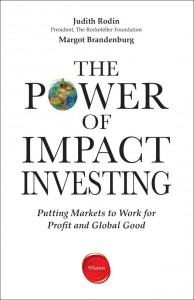This is the book I wish I could have read when I first started out in impact investing, over a decade ago. I started reading it on a flight back from New York to Mumbai. It is a testament to it that it managed to keep me engaged through the long flight. Seventy per cent overview of the impact investing sector, and 30 per cent toolkit on how to be an impact investor, this book is peppered with anecdotes and examples from all over the world. These diverse stories emphasize the credibility of its authors, who have been at the helm of the Rockefeller Foundation and its impact investing initiative, which literally coined the term ‘impact investing’ in 2007.
 The authors set impact investing in its historical context, from the 19th century alignment of investor values and markets (where religious institutions avoided supporting ‘sin stocks’ like alcohol or tobacco) through the expansion of the socially responsible investing (SRI) industry in the 1970s to microfinance and CSR in the 1990s. It’s a valuable reminder for such a nascent industry: impact investing has deep roots.
The authors set impact investing in its historical context, from the 19th century alignment of investor values and markets (where religious institutions avoided supporting ‘sin stocks’ like alcohol or tobacco) through the expansion of the socially responsible investing (SRI) industry in the 1970s to microfinance and CSR in the 1990s. It’s a valuable reminder for such a nascent industry: impact investing has deep roots.
Modern definitions of impact investing are more active, highlighting the explicit goal of supporting ventures that pursue a social and/or environmental benefit in addition to profit. The book draws a clear distinction between modern impact investing and other forms of capital deployment such as socially responsible investing and venture philanthropy. The authors map the players in impact investing – across investors, intermediaries and enterprises – and highlight opportunities across multiple objectives, asset classes and investment vehicles.
Their chapter on support systems assesses the infrastructure that the impact investing industry has and will need, and addresses three critical demand–supply gaps with minimal jargon and some optimistic crystal gazing. The first is the increasing demand for impact investing itself (the authors cite a 2010 study of 4,000 plus American individuals, of whom half were interested in impact investing products). The second is the perceived demand and supply mismatch of capital and deals – an issue that the authors tackle with directness and a laudable lack of drama. And the third is the demand for data on prior performance in impact investing. As the JP Morgan˗GIIN 2011 survey highlights, this is one of the biggest barriers to industry growth for investors. The authors highlight the critical role of measurement systems and the need for certification and impact ratings. As an industry, we need the next evolution of innovative global benchmarks to build on the early pioneering efforts of GIIRS and B Corps.
My favourite parts of the book were the last couple of chapters that demonstrate how impact investing is developing around the world. The strong emerging markets showcase includes overviews of policy frameworks and information systems, as well as an example of a challenging impact investment and how it could have been fixed earlier. This sets the tone for the last chapter, which shifts the focus from ‘what is impact investing’ to ‘how to be an impact investor’. This – along with the appendix – is a comprehensive and clear array of tools and resources for both the new and the sophisticated impact investor.
Some of the examples cited include well-documented success stories such as 1298 and d.light. I found reading about the work of less-marketed enterprises like Saiban in Pakistan or the You Cheng Foundation in China more valuable. It would also have been interesting to hear more about the global gaps in the toolkits provided to wealth managers. Despite the increasing wealth in Asia, for example, wealth managers are not yet pushing the envelope on impact filters on investing. My own wealth managers looked at me like I had grown three heads when I first talked to them about why I didn’t want to invest in extractives and asked for a range of ‘positive investments’. I will be sending them a copy of this wonderful and comprehensive book.
About the book
Published by: Wharton Digital Press
Price: $16.99
ISBN: 9781613630365
Shalaka Joshi is managing director, Asia-Pacific, Toniic. Email shalaka.joshi@toniic.com






Comments (0)